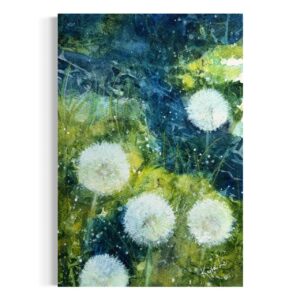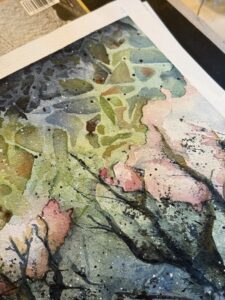Have you ever noticed how nature doesn’t really do straight lines? Think about an untamed garden or a windswept coastline – there’s a beautiful, cyclical rhythm to it all, a way of growing and connecting that’s far from rigid. As an artist, especially one who loves painting florals and landscapes in watercolour, I find tapping into this natural wisdom completely transforms my work.

It’s something I often chat about with people who collect my art and fellow artists: shifting your perspective to embrace nature’s cycles unlocks a deeper connection, both to the subject and the creative process itself. It’s less about perfect replication and more about capturing an essence, an energy.
So, how can we, as creators, infuse this circular, nature-inspired mindset into our own art? Here are five ways I try to incorporate it into my practice:
1. Look Beyond the Obvious Angle
Nature rarely presents things head-on, perfectly centered. Instead of painting that rose from its most conventional view, try imagining it from below. What does the architecture of the stem look like? How does light filter unexpectedly through the petals from that angle? Exploring unusual perspectives helps break free from predictable compositions and mirrors nature’s own complexity.
2. Embrace the “Untamed” Beauty
Forget flawless representation for a moment. Nature is full of beautiful imperfections – a bent stem, a wilted petal, asymmetrical growth. These aren’t flaws; they’re character. Allowing these elements into your floral art or landscape paintings adds authenticity and reflects the real resilience and beauty found in the natural world. Let your lines be a little wild; let the composition breathe.
3. Listen to the Cycles of Creation (and Letting Go)
Nature operates in cycles: growth, bloom, decay, renewal. This constant flow can inform our art process. Don’t be afraid to layer, to let things evolve on the paper. Sometimes a painting needs to sit, to “decay” a little in your mind, before you see the path to renewing it. It’s not always a linear path from start to finish.

4. Work With Your Medium, Not Against It
Watercolour, in particular, has such a beautifully fluid, slightly unpredictable nature. Instead of trying to control every drop, try surrendering to it a little. Allow pigments to mingle and bloom organically on wet paper, much like wildflowers popping up in a meadow. This approach turns painting into more of a dialogue, a dance between your intention and the medium’s natural tendencies.
5. Paint the Feeling, Not Just the Form
Ultimately, connecting with nature’s circularity is about capturing an energy. It’s the feeling of the wind moving through grass, the quiet resilience of a flower pushing through soil, the interconnectedness of a forest floor. When you focus on translating that feeling, that essence, your art gains a depth that resonates more profoundly than a purely visual copy.
Bringing Nature’s Wisdom to the Canvas
For me, embracing this mindset means my watercolour paintings feel more alive, more authentic. It’s a continuous practice of observation, letting go, and finding beauty in the organic flow of things.
I hope these ideas spark something in your own creative practice! Perhaps you’ll find a new angle for your next floral painting or let your landscape art breathe with a little more wildness.
Explore the results of this approach in my shop, where you’ll find original paintings and art prints born from this dialogue with nature. I’d love to hear your thoughts – how does nature inspire your creativity?


